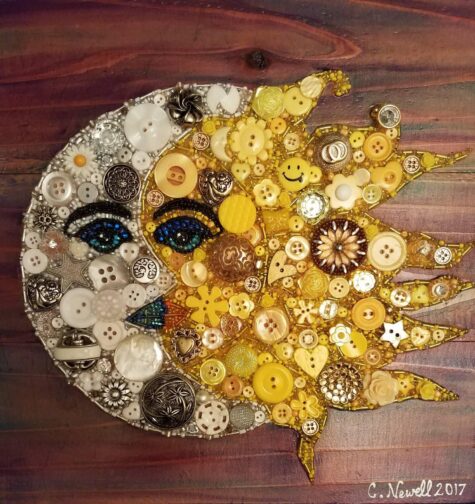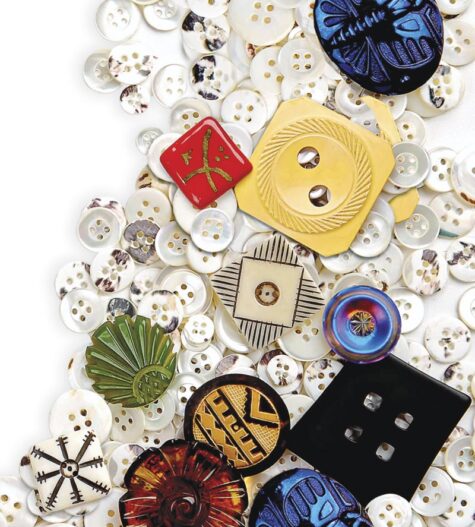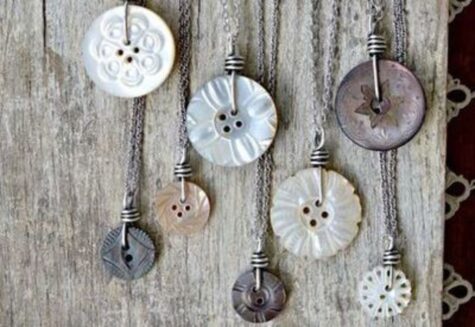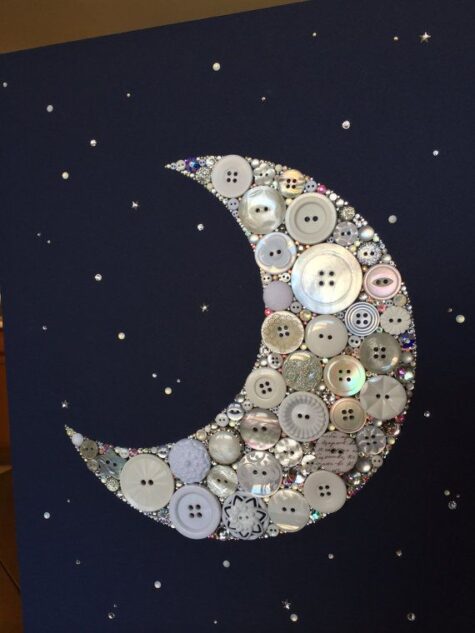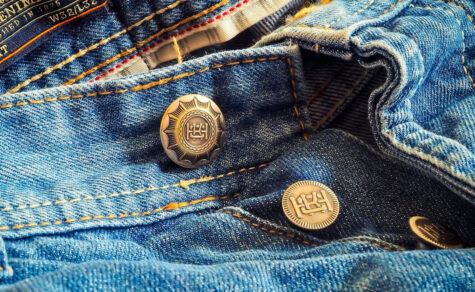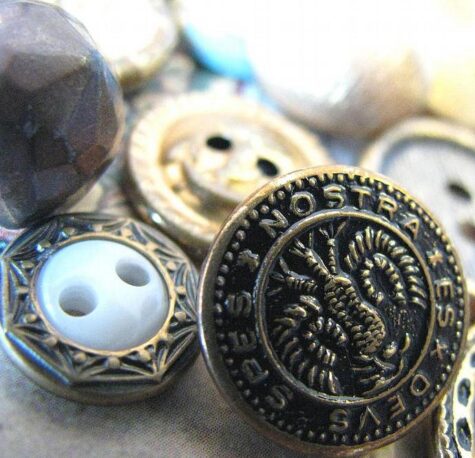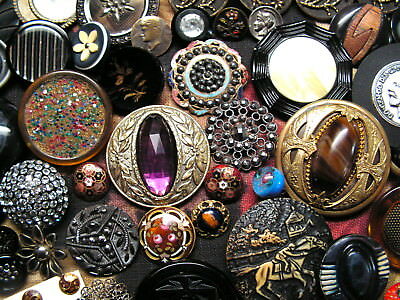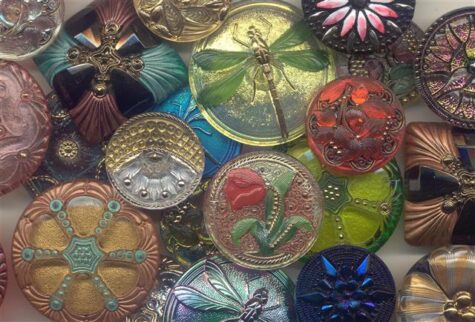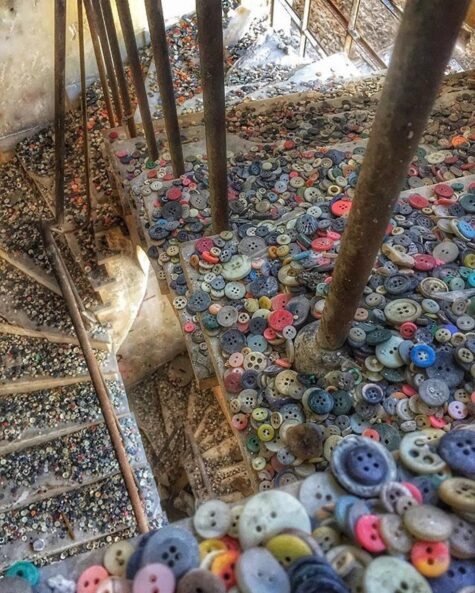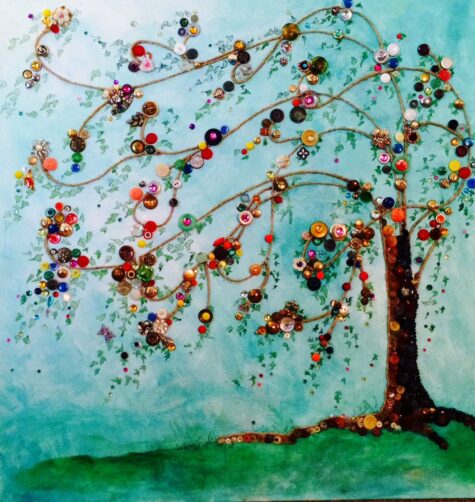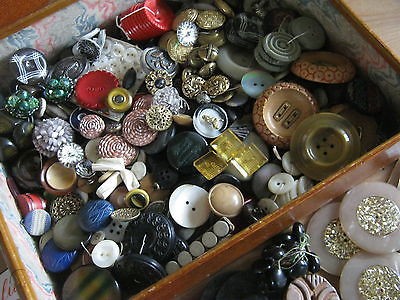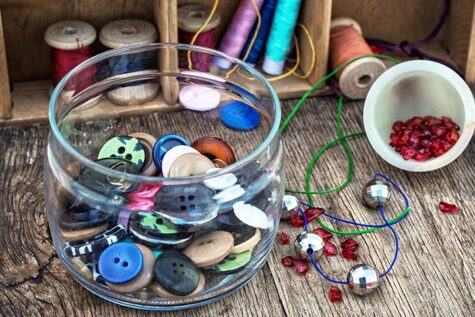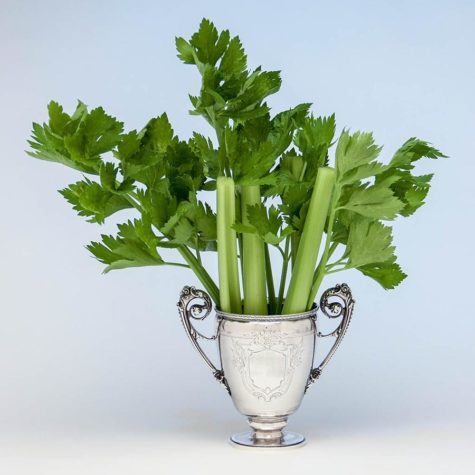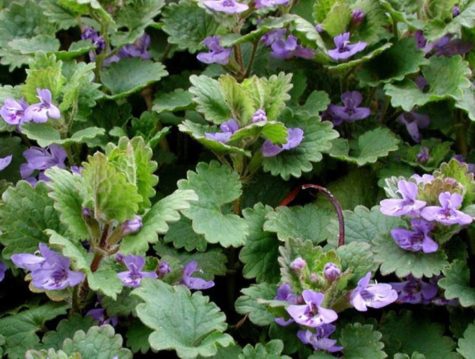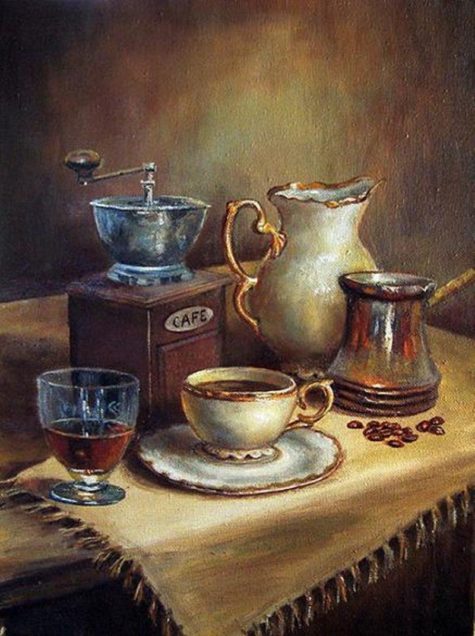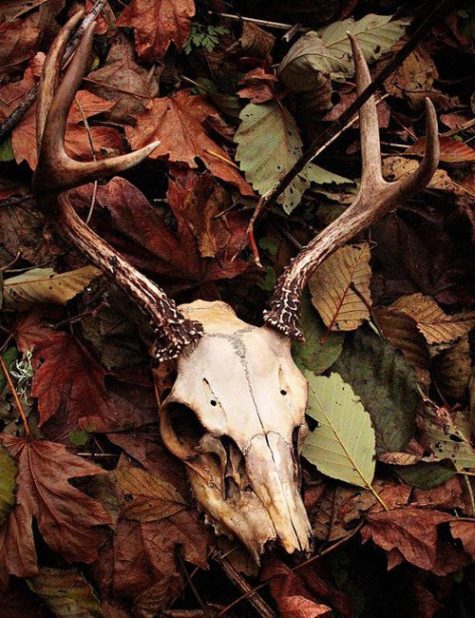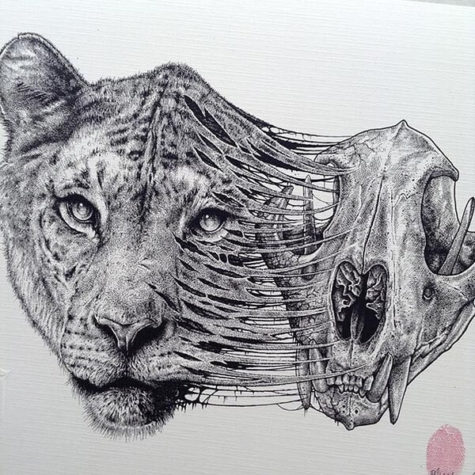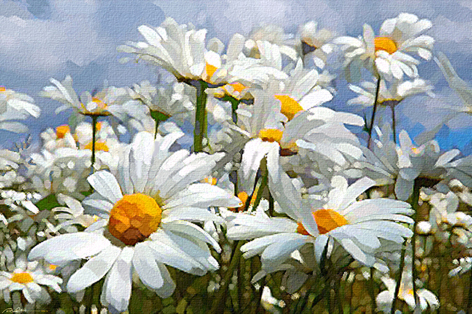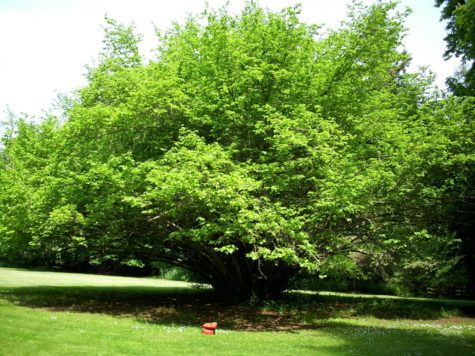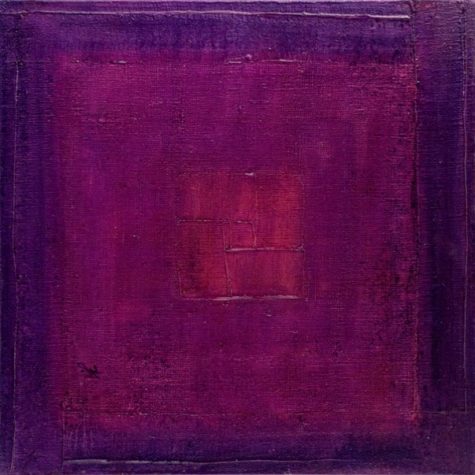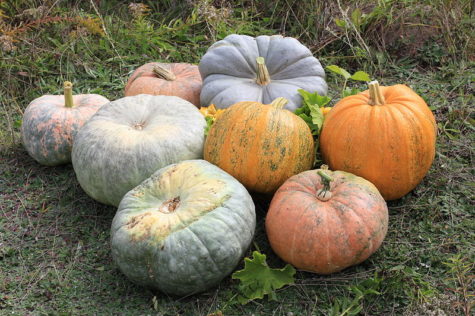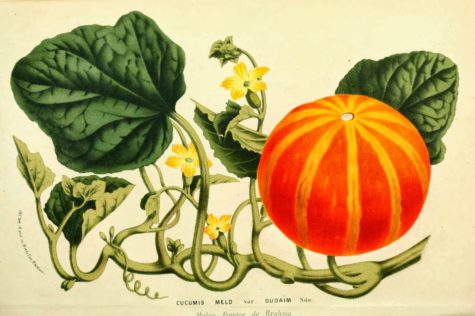Divination
Buttons are incredible little tokens much like coins or rocks that can be used for a plethora of fun and useful witchy crafts. They’re small, portable, wearable, transferable, and can be made easily or found for very little money at most thrift stores and craft shops!
Think of their physical function – they keep clothing and linens closed….therefore protecting what is underneath from weather, illness, dirt, etc. So automatically, with buttons think protection and comfort. Also, buttons are tools that sit on a threshold. YES. The threshold between us and the outside world! So they are also useful in spirit work.
Meditate on buttons and you start seeing all sorts of sort of oppositions – the sort of sex and death, Lear, at the end of King Lear where Cordelia is dead he asks somebody to undo her button to help her breathe and at the same time we have buttons as the things you fumble with before the act of generation.
In ancient gypsy traditions buttons represent sense of renewal.
Who knew buttons are magickal little tools? Our ancestors did, of course! Did your grandmother or aunt keep a tin or container of random buttons? Mine did and gifted to me. At the time, I wondered why a tin of buttons was so important. Now I know. If you were blessed with a tin of buttons from your family, keep it and make use of it!
- Ancestral work!
If anyone in your family has sewed they probably have a box/jar/tin of sewing supplies left around with some buttons in it! Use these on ancestral altars to again create that connection.
- Friendship spells!
Buttons are a kind of clasp or connection, therefore using buttons in spells for bonding can symbolize a connection, or clasp, of two or more people!
- A Button Magick Charm Necklace
Back in the day our ancestors collected and saved buttons. If you have a collection of buttons, you can make a magickal button necklace. Or what was once called a wishing necklace. For each button you string onto the necklace, pray over it your intention. Different colors for different intentions, etc. Make it fun and be creative!
- Divination.
Often buttons are used for eyes on dolls and stuffed animals and placing a button in front of you during a divination ritual can help you visualize and therefore open your third eye.
- Elemental Buttons
Buttons of certain materials can be used to harken back to certain elements, like clay or wooden buttons for Earth, or shell buttons for water.
- Altar Decorations
Buttons can be used as altar decorations, and larger buttons can act as tiny plates, display stands, or bases for mini offerings!
- Button Magic With Bags and Bottles
Buttons are great to add to shaker jars. When you shake the jar, they make awesome sounds! For me, part of the allure of a shaker jar is not only the prayer while shaking, but the sensory stimulation. The sounds release energy along with your prayers.
Also, buttons can be added to spell bottles and bags. Again, choose colors and styles matching your intentions. Think of the button’s job in the spell as “buttoning” up the situation.
- Sigils
Draw or paint sigils on the back of buttons with a sharpie and seal with some clear glue/resin. Sew them onto your shirt, bag, or thread them to wear as jewelry!
- A Declaration of Love
Japanese male students often confess their love to a female by giving them the second button from the top of their school uniform. The second button is the one closest to the heart.
Sewing Buttons With Intention
- To attract money – attach the button with the letter Z with a diagonal strip to the other side.
- For many fans – the stitches should be in the form of an hourglass: two horizontal stripes and the letter X in the middle.
- To strengthen friendship – an equal sign;
- Success in creativity – the letter A.
- Success in business – letter Z;
- Harmony with the outside world – a square;
- Gaining developed intuition – two vertical stripes;
- Health promotion – the cross;
- Increase of well-being – a cross and two verticals;
- For gaining passionate love – a cross and a square.
Dreaming About Buttons
It is important to understand that the dream is a source of mystery and fascination dependent upon the significant details of the button in your dream. Also, take into consideration your own thoughts feelings and experiences related to buttons and what they might personally mean to you.
There are three types of dreams about buttons.
- A button in relation to a garment.
- Part of the body, as in a belly button.
- A button in connection with a push-button switch.
What we are talking about here, in this article is the meaning of dreams about the type of button that is a fastener or decoration on clothing. As you can see there are many different meanings, and variations of meaning.
What does it mean to dream about buttons? One thought process when you dream about buttons is that you have the ability to hold a situation together.
Perhaps people rely on you to be the glue that keeps everyone together. Maybe you yearn for someone else to take on this role if it’s a big weight on your shoulders.
Buttons often indicate that two people need to come together as one. Or perhaps you want to get closer to someone in your waking life, even if their views oppose yours.
If the buttons were large, then you may need to invest a lot of time and effort into reconnecting with this person. If the buttons were small, perhaps the change you need to make is very small but will have a significant impact on your relationship.
If the button is broken in your dream this divides the dream meaning, it could mean a split decision, or that things could go one way or another.
When you see a broken button in a dream, it may also mean that you look at many things negatively. The worries and problems that you have are a part of life, and you should overcome them slowly. You need to know that there are no completely carefree people. Don’t miss beautiful moments because of pessimism.
Dreaming of finding a button means that you are in a difficult situation, but you are not losing hope of getting out of it soon. That is the right way of thinking because you would have a harder time solving that problem if you were in a bad place mentally. If you can’t solve a problem right away, sleep on it. Your mind will be clearer, so you will come up with a solution faster.
When you are dreaming of sewing in a button on something, it means that you don’t like to spend money. You probably had financial problems in the past, so you have learned a lesson that stopped you from finding yourself in that situation again. You are watching every penny now and trying to save some for emergencies. You would rather gladden your loved ones with gifts than spend that money on yourself.
Another possibility is that you want to do something you love. You probably tried to do a job that you went to school for, but you have realized that things are not as they seem. You will make a decision to change your profession after many sleepless nights, but many people will judge you for it.
Alternatively, if you dream of sewing buttons onto an item, you might shortly lose a friend over a minor disagreement.
If someone else in your dream is sewing in a button on something, it means that you will cut every contact with someone you care about. Nothing specific will happen for you two to distance from each other, but you may stop hanging out because of different priorities or views on life. You will be sorry at first, but you will soon realize that life goes on. The good thing is that you will not argue, so you will be able to look them in the eye when you see them on the street.
If you are dreaming of unbuttoning your clothes, it means that you are ready to open up to other people mentally, emotionally, and sexually. You will realize that you have been missing out on many things because of stubbornness and the defense mechanism that you have created to protect yourself from people. If you have been single for a long time, your decision will be crucial when it comes to changing that. If the relationship with your partner is not the best, you will finally get enough courage to tell them what is bothering you.
It’s also possible the dream is telling you to share your thoughts and feelings with someone if you have a habit of keeping everything close to your chest.
A dream in which you are buttoning up your clothes symbolizes your firm attitude toward strangers. Those close to you know the true you only. Everyone else sees an arrogant person who believes that they are better than others. When you let someone get closer to you, they usually change their opinion of you entirely.
It may also symbolize your tendency to keep your emotions to yourself and keep your feelings in check. Are you doing this more than you normally would? If so – why?
To dream that you are doing up a buttoned coat indicates that you would never be perfectly wealthy in the future – you would always want more in life — sometimes money cannot buy happiness.
A button in a dream symbolizes gain. You will successfully finish one project that you have invested a lot of time and effort in. You will be extremely dedicated to every detail and make sure to do the job the best you can. Your superior will be amazed by the results, and they will be happy to do business with you again.
The actual buttons and design also need to be taken into consideration. If the buttons are large then this indicates that you need to put a lot of energy into projects going forward. A particularly small button in your dream indicates that you need to be more confident in business matters.
Wooden buttons indicate that times are going to be difficult for the next few months, however, that you’re going to overcome these difficulties as they will be followed by rebirth. If the buttons are made of plastic you may receive some good ideas in your life if you dream of a button that isn’t made of plastic then you are likely to encounter trouble over enterprise and you should take the advice of friends.
When you see a red button, it means that you will react too violently to the criticism your loved ones or superiors will give you. You will not have an understanding of their advice since you believe that you are right.
People usually see black buttons in dreams, which symbolizes stability. You might be afraid that you will lose a job, or you are worried about your children’s future. This dream symbolizes the fear of uncertainty, which is justified in your case.
White buttons predict conflicts and problems with a loved one that you will overcome if you realize how much that person means to you only. If you have recently had an argument with your partner, you will decide to make peace with them as soon as possible so that you can stay together.
A golden or shinny button on a uniform can have multiple meanings. When younger people dream of it, it symbolizes their desire to prove themselves and make progress in their careers. If a young woman has this dream, that symbolizes her desire to marry someone rich and have a bright and carefree future.
When you see a multiple-colored button in a dream, that symbolizes progress. You will probably pass an important exam with flying colors or finish a difficult project at work. You will be proud of yourself since you didn’t hope that you will get rid of such a big worry in such a short period of time.
To see buttons on a cloth indicates that some people in your life are going to be difficult in the forthcoming future. It is your prerogative to ensure that you overcome these difficulties and work well with other people. If you are a man and you received this dream if indicates the need to be honest with people.
It is important for you to recognize that people in your life often influence you. To dream that you see more than one button in your dream is an indication that you’re going to encounter the medical profession.
To dream that you are in a shop and purchase buttons indicates that your companions are going to be kind of thoughtful towards you.
Dreaming of buying buttons means that a friend’s or loved one’s gesture will amaze you. Someone will put in an effort to surprise you with nice words or deeds. You will remember that moment for the rest of your life. Another meaning of this dream is renewal. You may get in touch with someone who meant a lot to you in the past.
If you are dreaming of selling buttons, your subconsciousness is warning you that it is time to improve your relationship with a loved one. Frequent arguments or conflicts have destroyed the harmony in your relationship, so you have distanced from one another. You miss the conversations you had and pieces of advice you got from them. Because of that, you should leave your pride aside and show understanding and readiness to compromise.
To drop a button in your dream indicates that you’re going to have more pain or injury in the near future. If you dream of seeing buttons on children in the dream will fill the need for to the minor reasons of society. The dream also indicates that you are likely to attend church in order to find a more specific meaning of your existence.
To dream of many buttons in a row is an indication that you should avoid being superstitious. This dream also signifies that you do not like high school or the learning environment.
If you dream of many buttons on a pile, that symbolizes indecisiveness. You second guess every decision you have to make. Don’t complicate your life for no reason. The easiest solutions are always the best.
A dream in which you lose a button suggests that you should manage money better. You have been spending everything you earn lately, so you often have to reach in a piggy bank reserved for emergencies. Think about your priorities and make a monthly budget plan. That is the only way to control your expenses and realize where you are making mistakes.
Don’t forget! The meanings of dreams be simple. If you have recently sewn buttons on your clothes, and that has made an impression on you, you may dream about it. Dreams that have special meaning are usually dreams that are quite vivid and stay in your mind.
Button Superstitions
Buttons and the superstitions surrounding them are fascinating. While we tend to think very little about these ancient fasteners, our recent ancestors had a lot to say about the magick in buttons.
For example, it is believed that you cannot sew a button “on yourself” so as not to sew up the mind and memory . As an antidote, it is recommended to clamp a thread or other object between your teeth, even a piece of clothing.
Another belief says that sewing buttons on right before the New Year is not the best idea. Better to wait until the next day.
If you are preparing to meet a person who is unpleasant for you, then fasten all your buttons as tightly as possible. The buttons will work like a talisman and protect from any negativity coming your way.
Losing a button from your shoe is bad luck. The only way to get rid of the bad luck is to either spit in your left shoe or spit over your left shoulder.
Most people know that it is bad luck to do up buttons incorrectly. Fortunately, the remedy is easy; all you need to do is undo the buttons, take off the item of clothing, put it on again, and then do up the buttons correctly.
It is good luck to do up an odd number of buttons. If your garment has three buttons, for instance, you can do up either one or all three of them. However, if your garment has two buttons, you should do up the top button only, or leave the garment unbuttoned.
A seventeenth-century rhyme used for counting cherry stones, daisy petals, and other small objects was sometimes recited with buttons. Young women could count the buttons on their clothing to determine whom they would marry.
Tinker, tailor, soldier, sailor,
Rich man, poor man, beggerman, thief.
Like counting flower petals, girls would grab a handful of buttons and count them out to the “He loves me, He loves me not” chant. The last button gives the answer.
Make a wish over a button and throw it into a well. The well fairies like buttons and are said to grant wishes in exchange for a button or two.
- Should you find yourself sewing a button for a bachelor, you will marry him within the year.
- Putting old buttons on a new coat was considered bad luck.
- If a button pops off on a business suit, your luck in business is about to change.
- If three buttons fall off a garment, expect a funeral in the near future.
- A coat with eight buttons brings good luck.
- If someone is spreading lies about you, bite the top button of your shirt and the liar will get a blister on his tongue.
- Gifting buttons is to gift good luck. It brings the receiver good fortune.
The semantic meaning of the word “button” in Russia for many centuries consisted in the verb “scare”. The accessory, in addition to its utilitarian function, played the role of a talisman and served to scare off hostile forces. In the omen about the black cat that crossed the road, to neutralize the negative, you had to take the button and continue on your way. It was believed that this amulet would not allow anything bad to happen.
What does it mean to find a button?
Just because you come across a button, it doesn’t mean that you should pick it up. Everyone must decide for themselves, pick up a button or leave it on the road. A superstitious person will certainly pay attention to the number of holes.
Buttons with one or two holes should be left where they are. Especially destructive is the finding of a button with traces of thread still attached. Popular beliefs warn of imminent misfortunes for the one who appropriated this accessory, because all the illnesses and adversities of the previous owner will go to the one who picked it up.
An important factor will be the color scheme, which suggests that you can pick up only a button with four holes of any color except black.
If found on the street, then this is a good sign. This button portends luck in any undertakings, an easy way to fulfill wishes, the possibility of pleasant changes in life. Sometimes it is interpreted as a prediction of a long journey.
A button found in another busy place is also a good sign: on the verge of a change in life and a high appreciation of professionalism. It was also said that if you find a button while undertaking your daily tasks it is a sign that you’ll make a new friend.
If you find a button on the ground, and decide to pick it up and put it in your pocket, you will have good luck for as many days as the button has holes.
- Green is money.
- White is joy.
- Red is love.
- Blue is success.
- Black is grief.
If you came across a black button in your path, you should NEVER pick it up! It was a sign of bad luck or a curse.
It is especially lucky to find a button with four holes. If you find one, you can count on good news, and if the color of the button is white or green, then in addition to good news, you can expect cash receipts.
Finding buttons also holds different meanings based on which day of the month the button crossed your path.
- A finding in the first seven days of the month means that recognition of the person’s professional merits and his appointment to a new position is soon expected.
- In the second week – it promises good luck in love;
- In the third week – serves as a promise of change in personal life;
- At the end of the month – the possibility of large purchases and unexpected finds.
If a button with two holes is found – you should expect good news related to family or work. Possible unexpected financial receipts or a fundamental change in bachelor status.
On the road lies a talisman with four holes – a series of pleasant events and news awaits a person, and if you sew it in a secret place, the button will work to attract whatever is desired.
If you really want to pick up someone’s loss, pay attention to its color . According to popular beliefs, it predicts joyful or sad events that await in the near future:
If the button is still in the hands, then you can not keep it in your pocket – this will lead to a quarrel between friends or relatives. It is better to sew it on the wrong side of the garment, so that it will be closer to the heart, but invisible to others. Sewn in a special way, it will serve as a talisman, as many centuries ago.
National Button Day
National Button Day on November 16th celebrates the function of buttons and the hobby of button collection. Some people like to collect buttons for their sparkle and cuteness and others collect signature buttons that have been somehow important to them. There are thousands of button collectors in the United States. Crafters across the country utilize buttons in creative ways.
Take some time on this day to either go though your existing button collection or start a new one, and enjoy Button Day to the fullest! Who knows, perhaps you possess in your collection an antique button that’s been passed down for so long that you’ve never stopped to think about where it came from. Keep your eyes open! Every now and them someone discovers a treasure that had just been sitting around collecting dust at their home. And even if you don’t, an all you have is regular buttons, don’t worry and just enjoy an afternoon looking at the pretty, shiny little things. At the end of the day, people are animals, and there’s nothing animals like better than something pretty and shiny.
About Buttons
Buttons come in different materials, patterns, designs, and sizes. Buttons have been made of a variety of materials. Ancient buttons were formed from natural and readily available substances such as stone, shell, bone, clay, or wood. In more modern times, metals, plastics, resins, and acrylics have been used. While buttons were created to fasten two pieces of cloth together, they also served as decoration.
While buttons today can be simple disks with two or four holes allowing a needle and thread to pass through, button makers create more elaborate designs. If you can imagine it, there’s probably a button like it. From animals and food to iconic buildings and famous people, button makers make them. They’re colorful and fun. While the fun ones may be less practical, they still function.
The origin of buttons can be traced back to 2800 BC where shells were used for making ornaments and seals. However, buttonholes with buttons as fasteners first emerged in Germany and from there, spread throughout Europe.
The wearing of gold, silver, and ivory buttons in fourteenth century Europe was an indication of wealth and rank. Expensive buttons were also made of copper and its alloys. The metalsmith frequently embellished such buttons with insets of ivory, tortoiseshell, and jewels.
There was a button mania in the late Middle Ages, resulting, in some outfits adorned with thousands of buttons, all of them with accompanying buttonholes. Dressing and undressing became a laborious process, but created a niche for the employment of professional dressers.
In the 15th or 16th century someone discovered that a loop slipped over a button, or a button pushed through a slit in the cloth, made a better fastener for the close-fitting garments that were coming into style. For some time, however, the chief use continued to be ornamental.
The asymmetrical fastening of jackets of the wrap over style came into fashion in China during the 15th and 16th centuries and was worn by men and women, royalty and peasants. It was the material and the buttons that showed rank. Peasants wore rough cloth fastened with anything that came to hand while the emperor wore silk and furs fastened with jewels.
In the 1700’s metal buttons were used and button covering was created. Metal threads were wound about a button in intricate patterns. Miniature scenes were painted on ivory or glass buttons. Some buttons were engraved and inlaid with silver.
Frederick the Great organized the buttons on soldiers’ coat sleeves being sewed on the top sides of their sleeves. This was to ensure that the soldiers would scratch their faces open every time they tried to wipe their noses on their tunics.
Men shirts have buttons placed on their right and the women have buttons placed on the left. There is a difference because mostly men dressed themselves using their right hands and the wealthy women were usually dressed with the help of maidens and the left side position of the buttons was necessary for doing it easily. The pattern is still followed today!
Sources:
- The Complete A-Z Dictionary of Dreams
- National Day Calendar
- Strange Ago
- Timurevts
- Encyclopedia of Superstitions
- Aunty Flo
- January Witch
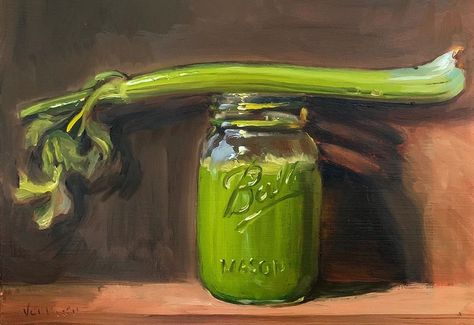
Magickal Uses
- Ruler: Mercury
- Element: Air
- Parts Used: Seed, Stalks, Oil
- Magickal Influences: Psychic awareness, Sleep
It should be mentioned that this is the garden celery under the rulership of Mercury, rather than Wild Celery, which is under the dominion of Venus.
This herbal seed, found in most kitchens, is used as a Visionary Herb. There are forms of divination which recommend drinking a tea of the seed as it opens the mind and allows for better concentration.
Use celery seed to increase male virility. Men can either eat it or add it to poppets in sympathetic magick spells.
To awaken your psychic awareness, crush about a teaspoon of the dried seeds and tie up in a piece of thin, cotton cloth. Inhale the odor and visualize your conscious mind relaxing (perhaps as a fist relaxes), allowing true communication with your psychic mind to occur.
- Rub the oil into fingers or the third eye to increase communication skills.
- Eat raw celery to remove blocks and fears and to promote weight loss.
- Cook the stalks in soup for love.
Folklore recommends putting celery into an herb pillow to induce sleep. Chewing celery seeds reportedly enhances concentration. Or burn them with orris root (iris roots) to enhance psychic powers. Witches flying on their brooms chewed celery seed to prevent dizziness.
Celery is sometimes used as a cure for impotence. Several sticks of celery need to be boiled in a saucepan of water until the celery turns into a pulp. The person with the problem needs to eat this while it is still hot, and can then look forward to a night of successful lovemaking.
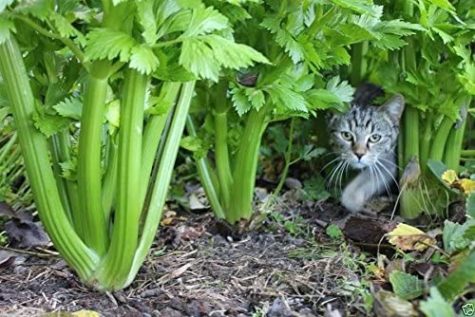
Folk and Other Names
- Aches des Marais
- Ajmoda
- Ajwan
- Apii Frutus
- Apio
- Céleri
- Celeriac
- Fruit de Celeri
- Graine de Céleri
- Karmauli
- Maiden’s Smallage
- Persil des Marais
- Qin Cai
- Smallage
- Selleriefruchte
- Selleriesamen
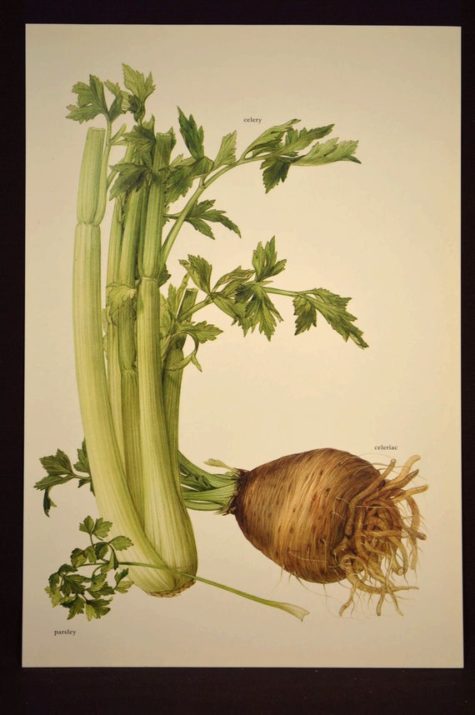
Folklore and History
Celery had its beginning several thousand years ago in shallow swampy areas of mainland China. The plant was prized for its seed, used medicinally and as a flavoring, and mentioned in the writings of Confucius. This would place it at about 500 B.C. on the world timeline.
A similar plant grew in the Mediterranean. It had a strong aroma (its Latin name means “strongly smelling”) and dark green leaves. The Greeks fashioned wreaths from it to adorn the victors in athletic and musical competitions. The Romans considered deemed it an aphrodisiac. And garlands of the leaves were found in Tutankhamun’s tomb.
The modern name “celery” comes from Greek selinon. It was ascribed to Silenus (or Seilenus), the son of a nymph and lustful Pan (or, according to other depictions, Hermes, the messenger of the gods who transgresses all borders).
Silenus, constantly drunk and lecherous, is depicted as pot-bellied with a beefy bald head and often with the ears, tail, and legs of a horse. He was the leader of the lustful horde of satyrs as well as the teacher and companion of Dionysus, the god of inebriation. Half human, half horse, Dionysus symbolizes, among other things, the powerful animal drive. The association of this satyr with celery, emphasizes the plant’s use as an effective agent of sexual potency.
Celery is presented as signifying both death and sensual pleasures in Homer’s epic The Odyssey: celery grows among violets in the meadows on Calypso’s magical island. (The Hellenes classified violets as “erotic plants,” which they dedicated to Priapus, the little deity with the big phallus; Aphrodite, the goddess of love; and Persephone, the goddess of the underworld and the dead.)
In the Odyssey, the enchantress Calypso took in shipwrecked Odysseus and held him enraptured for seven years; she also turned his men into “swine.” Comparative religion studies indicate that Calypso was a goddess of death, as the name suggests (kalypto = to enshroud) and that pigs were sacred to the earth and death goddess of antiquity.
That Odysseus ultimately freed himself from her magic is seen as a victory over death, as in all mythologies the hero, having come dangerously close to death, succeeds in wresting new life from the dark forces. This interpretation lends meaning to the ancient Greek practice of crowning winners of riding and gymnastic games with celery leaves.
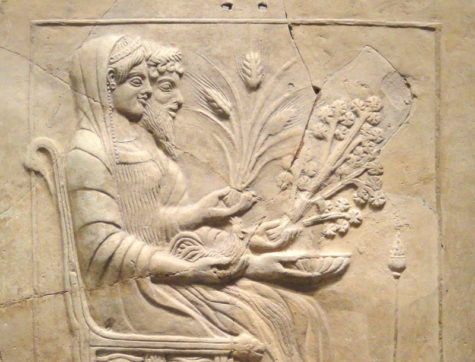
Celery has a long association with death. Ancient Egyptian mummies were often decorated with celery and blue lotus blossoms. Ancient Greeks planted it on graves and used it to season funeral feasts. The Roman Virgil (70–19 BC) described much the same:
“Godly Linus decorated his head with flowers and bitter celery [as a sign of mourning]”
“It is not right to put celery in common dishes because it belongs to funeral feasts.”
The Romans also dedicated celery, as part of the death rites, to Orcus, the god of the underworld, as told by Plutarch (45–120 AD): “We decorate our gravesites with celery.” Given such practices, it was considered a bad omen to see a cart loaded with celery first thing in the morning. And for someone who was marked by death, the Romans said: “There is only celery left for him.” This is an interesting angle given the fact that, like the ancient Greeks, Romans also crowned their victors with celery leaves. And celery, next to dill and coriander, was a favorite condiment in the Roman cuisine.
Celery’s association with death lasted well into our own times. Wend (Slavic) tradition in northern German Spreewald claims that merek (celery) protects against being haunted by the dead.
And the Italian fairy tale “Marianne and the Celery King” tells of a maiden who, attempting to pull a celery bulb from the soil is instead pulled into the ground; “the ground closed over them like water over a stone.” Below the earth, she finds a golden castle and an old, long-bearded hunchbacked man who resembles a celery root: the Celery King, who marries and impregnates her. But he is also an enchanted prince. After the heroine surmounts numerous tasks and challenges she is able to redeem the prince and bring him back to the world above the ground.
Nowadays such stories are given anecdotic value at most. However, traditional customs, folklore, and imaginative perception teach us much about the essence of the plant. In such imaginative terms, let us consider the celery.
Celery is a biennial; its “incarnation” lasts two years. In the first year, it concentrates on absorbing salty, moist earth forces, during which time it swells and becomes lush. During this year there is a clear pull to the dark, cool earth realm, to downward-moving elements and, figuratively speaking, to the grave, bitter death, and the mourning that causes salty tears to flow—but also to the fertile, ever-bearing primal source.
In the second year the plant ascends to the light, shooting up into bloom, opening and branching out as it bathes in cosmic light. The plant now sets a counterpoint to the earthy, moist, salty forces with its “light and fiery” essential oils.
Thus it becomes a plant for victors and heroes, one that overcomes the dark forces, that wards off the evil eye (in Spain), that thwarts the scheming of wicked witches. Even in modern Greece celery blossoms—together with garlic and onion—are hung for good luck. They protect the area where silk worms are being raised; small children are given amulets of celery to keep them from harm.
In Prussia and Pomerania the leaves were stuffed into cracks in floors and walls in pigsties to protect the animals from evil magic—and young married couples were given a piece of root to put in a pocket or a shoe for good luck.
Nicholas Culpeper (1616–1654) recognized the ambivalent nature of celery. He ascribed the plant to the hermaphroditic god, Mercury—the Roman Hermes, who can as easily fly up to the light-filled world of the gods as he can descend to the underworld. Indeed, Mercury-Hermes is the ruler of rising and sinking energy flow. He loosens, cleanses, opens, splits, and removes blockages by bringing everything back into flow.
Culpeper, just as other doctors before and after him, used this mercurial plant to heal “water diseases,” “obstructions” while urinating, and stone ailments, and to activate the liver and the spleen.
Celery works in the microcosm of the human body true to character. It affects the root chakra, the Muladhara, down into the sexual organs and the “salty, watery” urinary organs. Celery can reduce the milk flow for nursing mothers—a compress can actually temporarily reduce the breast size—but can also stimulate the uterus and bring on menstruation.
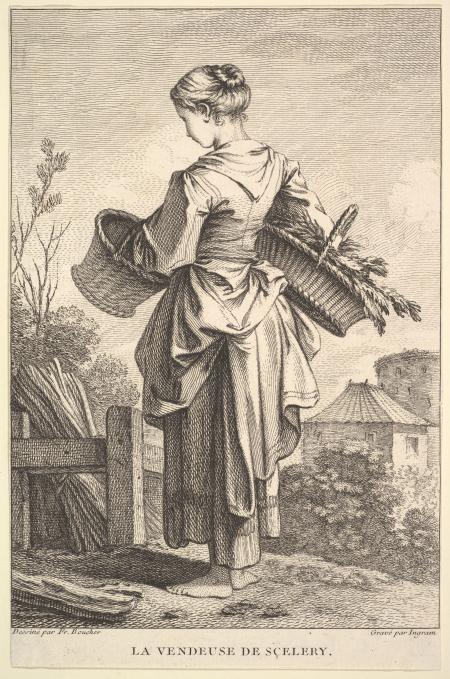
As “maiden’s smallage” it belonged to the herbs that women took in case of a “belated period,” when they feared they’d been impregnated. German scholar and bishop Albertus Magnus (1200–1280) described the downward pull of the plant: “Celery causes sensual desire to descend from the breasts of wet nurses to the genital area and bring about menstruation.”
It is often the case that emmenagogues work for men as aphrodisiacs, as indicated in such names as “stand-up herb” (Lausitz, Germany), “stand-up wort,” “stud wort” and “buck’s wort.” A fifteenth-century medical book tells us: “So that your wife stays faithful forever mix celery juice and honey and rub your genitals with the mixture. This way she will be satisfied and will want no one else but you.” Consider too this German saying:
Fry me eggs, sweetheart,
with celery and lettuce,
on Sunday we will go courting,
my mother told me this.
This aspect of celery is also well known in France, the country of savoir vivre and l’amour, as in the following: “If a woman knew what celery does to a man, she would be willing to go from Paris to Rome to find it.” And, “If a man knew what celery does for him, he would plant his garden full of it.”
In 14th-century Italy where the rich and curious began to selectively cultivate celery. The stalks became fatter and pleasingly crunchy; they paled from intense dark green to a subtle, delicate hue; and the taste evolved from bitter to pleasingly grassy and citrus-like.
When celery lost its flavorful wild side, it also became less rampant. These new strains were fussy and difficult to obtain, which of course made them irresistible to the elite. By the mid-19th century, celery was so prized by the upper class that serving vases were made specifically for the purpose of displaying it as the centerpiece at fine dinners.
While European epicures were feasting on blanched celery au velouté, American farmers were reveling in how easy it was to cultivate the luxury vegetable in the Great Lakes region. They were resourceful, ambitious, and even competitive when it came to growing celery.
As the celery craze was reaching its zenith in the 1870s, Dutch farmers who knew how to handle wetlands began growing the vegetable in the black, marshy soils of Kalamazoo, Michigan, which became known by the catchy name the Celery City. The streets were littered with hucksters peddling celery from street corners and train stations. As American cultivation improved, celery became an everyman’s item. By then, the British upper classes had moved on to French luxuries like truffles and oysters.
Sources:
- Magickal Aromatherapy by Scott Cunningham
- Publicism
- Encyclopedia of Magickal Ingredients
- Encyclopedia of Herbology
Also known as Creeping Charlie, Ground ivy has a strong connection with the powers of magick and divination. Folk names include:
- Alehoof
- Catsfoot
- Field balm
- Gill-by-the-ground
- Gill-over-the-ground
- Hay-maidens
- Hedge-maids
- Jenny-run-by-the-ground
- Lizzy-run-up-the-hedge
- Run-away-robin
- Tunhoof
Ground Ivy is bound to Saturn and water. It is used in magick mostly for divination purposes either by burning dried leaves, by using the oil to anoint a divinatory tool, such as a deck of Tarot cards or by drinking fresh or dried leaves in a tea.
Sachets, charms and teas made of fresh or dried ground ivy can be worn for help in rebuilding when you have given too much, as protection from theft, and for fidelity, honesty, and weddings or new love.
Considered a safeguard against sorcery it was worn by milkmaids when first milking cows in the pastures. A magic charm, it was used to prevent the cows from enchantment. In many regions the first milking of the cows was actually done through a wreath of ground ivy.
Other magical uses of ground ivy included promoting sleep, meditation, healing, love, friendship and fidelity. The ritual use of ground ivy was popular and the herb was often woven into crowns and garlands to be worn on Midsummer’s Eve.
Ground Ivy is very powerful in protection against evil magick and psychic attacks. Using this herb will help you in identifying other witches and will help you reveal who is using negative magick against you.
“To find out who might be using negative magic against you, place some ground ivy around the base of a yellow candle. Burn the candle on a Tuesday and the person will then become known to you.”
~Scott Cunningham
A tea of Gill-over-the-Ground may be sipped to help overcome shyness. Strewing leaves of this herb about the floors of your home is said to promote serenity and peaceful dreams.
If you celebrate Beltane, weave some stems and flowers into your crown. Pick an alias name for it that appeals to you—my personal favorite is Gill-over-the Ground. Repeat it several times until it rolls nicely off your tongue and sounds almost exotic. And, if you must pluck some of it, at least stop and pay homage to the myriad of uses of it throughout time. Ground ivy, a small herb with great determination!
Sources:
The Poplar or Aspen is the sacred Tree of the Fall Equinox – (Aprox. September 22).
There is a bit of confusion about poplar, aspen, and cottonwood trees. The tree referred to here is the genus “populus” which includes true poplars, as well as related trees such as cottonwood and aspen).
Here’s a quick list:
- Balsam Poplar (Populus balsamifera)
- Eastern Cottonwood (Populus deltoides)
- Bigtooth Aspen (Populus grandidentata)
- Black Poplar (Populus nigra)
- European Aspen (Populus tremula)
- Quaking Aspen (Populus tremuloides)
- Black Cottonwood (Populus trichocarpa)
As far as I could discover, the Aspen and Poplar tree magickal lore overlap, and can be used interchangeably, unless otherwise indicated. The lore does not refer to the Yellow Poplar (Liriodendron tulipifera), or Balm of Gilead (Populus candicans) which have different attributes and magickal qualities
- Celtic name: Eadha (pronounced: “Eh’ uh”).
- Folk or Common names: All Poplar – Popple, Alamo, Aspen; Trembling Poplar – American Aspen, White Poplar, or Quaking Aspen; Balm of Gilead – bombagillia.
Magickal Usage:
- Ruler: Saturn
- Type: Plant
- Magickal form: Buds
Carry poplar buds with you when seeking employment. Crush and add them to traditional money incense when you work on commission and need to attract more funds. The poplar buds may also be added to divination blends and make a great ingredient for psychics wishing to attract more business, as well as improving their powers.
The Poplar’s ability to resist and to shield, its association with speech, language and the Winds indicates an ability to endure and conquer. The Poplar is known as the “Tree that Transcends Fear”. Poplars symbolize the magick of joy, the aging of the year, resurrection and hope – and are connected to the Otherworld. Poplar can be used in magick done for success, passage and transformation, Hope, rebirth, divinations, shielding, endurance, agility in speech and language, protection, and love – and as an aid in astral projection.
Poplar can be used in protection charms of all kinds. Poplar is a good wood to burn in balefires and ritual fires since it offers protection. Shields can be made of Poplar since the wood is thought to offer protection from injury or death. Carrying Poplar helps to overcome the urge to give way under the burden of worldly pressures, and aids in determination. Poplar buds can also be carried to attract money and can be burned as an incense to create financial security.
Siberian reindeer-hunting cultures carved small goddess statues of Poplar (Aspen) wood. Groats and fat were then offered to the figures with this prayer:
“Help us to keep healthy!
Help us to hunt much game!”
Poplar buds are also sometimes added to flying ointments and was also used in astral travel. A medieval recipe for a flying ointment called for Cinquefoil, Poplar leaves, soot and bat’s blood obtained at the wake of the new moon.
The trembling leaves of the Poplar tree can be ‘read’ to divine messages from the God and Goddess, and also from spirits that drift into woods. The Poplar is the sacred World Tree of the Lakota nation. For the sun dance ceremony, a Poplar is carefully cut and lowered, then is re-erected in the center of the dance circle. While being carried the Poplar must never touch the ground. Green branches, a buffalo skull and eagle feathers were used to decorate the Poplar for this ceremony.
Aspen Lore:
A country name for the aspen is the Shivver-tree, a name which in some districts is also given to the poplar. The leaves of both trees tremble at the slightest stirring of air, so that they seem to move without ceasing when all around is still. Because of this, both trees were formerly credited with the power to cure agues and fevers.
A very old magical tradition held that ailments could most efficaciously be treated by something that resembled their effects; and since ague causes the patient to shake and tremble, he was likely to be healed by the shaking tree.
In his Folk-Lore of the Northern Counties, William Henderson relates the story of a Lincolnshire girl who was thus cured of ague. She was advised to pin a lock of her hair to an aspen, saying as she did so:
“Aspen tree, aspen tree,
I prithee to shake and shiver
Instead of me.”
As was usual in such charms, her journey home had then to be made in complete silence, otherwise the magic would not work. She followed the advice given, and many years later, when she was an old woman, she told Henderson’s informant that she had never been troubled with ague again.
Another method was to bore a small hole in the tree trunk, insert the patient’s nail parings, and close the hole securely. As the bark grew once more over the opening, so the disease would disappear.
Two widespread legends are told to account for the aspen’s trembling. One is that it was condemned to shiver thus for evermore because it was the only tree that would not bow down to Our Lord when He passed through the forest. The other is that it shudders perpetually with horror because its wood was used to make the Cross on Calvary.
Poplar Lore:
 The poplar shares with the aspen the country name of Shivver-tree because like those of the latter, its leaves tremble. It also shares, and for the same reason, the aspen’s power to cure agues and fevers. R.M. Heanley records a Lincolnshire charm in which the patient cut off a lock of his hair and wrapped round a black poplar branch, saying as he did so:
The poplar shares with the aspen the country name of Shivver-tree because like those of the latter, its leaves tremble. It also shares, and for the same reason, the aspen’s power to cure agues and fevers. R.M. Heanley records a Lincolnshire charm in which the patient cut off a lock of his hair and wrapped round a black poplar branch, saying as he did so:
When Christ our Lord was on the Cross,
Then didst thou sadly shivver and toss.
My aches and pains thou now must take,
Instead of me I bid thee shake.
He then had to go straight home, speaking to no one on the way, after which he would be free from ague forever. Heanley adds that some people considered it necessary to fast for twelve hours before attempting this charm.
The constant shaking of the poplar is often accounted for by the legend that its wood was used in the construction of the Cross. Medieval Legends of Christ (1934), mentions two explanatory legends. One is that it was under a poplar that Our Lord prayed during His agony in the Garden of Gethsemane, and that the tree has trembled in sympathy ever since. The other is that it was cursed because, alone among the trees, it refused to mourn at the Crucifixion, saying that Christ died for sinners, “but I am innocent, and His suffering is no concern of mine.”
Poplar leaves were supposed to be one of the ingredients of the witches’ flying ointments.
Magical History and Associations:
In Gaelic tongue the tree was called Peble and Pophuil in the celtic way. Poplar is generally a plant of Jupiter, Saturn and the Sun and is associated with the element of water. Its color is rufous (red) and the bird associated with Poplar is the Whistling Swan. The stones associated with Poplar are Amber, Citrine Quartz, Sapphire and Swan Fluorite. The Anglo-Saxon rune poem seems to refer to the Poplar as being associated with the rune “berkano”.
Heracles wore a crown of Poplar leaves in triumph after killing the giant Cacus (the evil one) and retrieving Cerberus from Hades. The upper surface of the Poplar leaves was thus darkened from Hades’ smokey fumes. Poplar trees are sacred to the Mesopotamian goddess Ua-Ildak. The Grass King of Grossvargula, who was seen as having fertilizing powers, went on horseback wearing a pyramid of Poplar branches and a crown. He led a procession of young men about the town and was then stripped of his branches beneath the Silver Lindens of Sommerberg.
Poplar (Aspen) is said to be the tree of the Autumn Equinox and of old age, and is known as the shield makers’ tree. The Black Poplar was a funeral tree sacred to Hecate as death goddess, to Egeria, and to Mother Earth. Plato makes a reference to the use of Black Poplar and Silver Fir as an aid in divination. The Silver Fir standing for hope assured and the Black Poplar for loss of hope. The Grove of Persephone in the Far West contained Black Poplars and old Willows.
In ancient Ireland, the coffin makers measuring rod was made of Aspen, apparently to remind the dead that this was not the end. In Christian lore, the quaking Poplar (Aspen) was used to construct Christ’s cross, and the leaves of the tree quiver when they remember this fact.
Herbal usage:
Poplar can be used as a tonic, chiefly used in treating fevers. The infusion has been found helpful in treating chronic diarrhea. The sap collected from the buds can be used to make a healing ointment and can be used as an external application in bruises, swellings, and some skin diseases. Teas can be made from the Poplar buds and are useful in helping treat arthritis and rheumatism.
Source: Dutchie.org
- Provides peace of mind and grounding.
- Helps to dispel nightmares, negative thoughts, and overcome blockages and unhealthy emotions. It’s great for protection and getting rid of all kinds of nasties.
- Coffee is a stimulant and can be used to give spells, potions and charms an extra kick, or speed things up.
- Coffee grounds can be used in divination and read like tea leaves.
- It is considered excellent for curse breaking.
- It can be used as an offering to deities, entities, and ancestors.
- Some sources suggest it can be used for compulsion, and encouraging others to be more persuasive towards you. This is most effective when the coffee is served to the target.
Bubbles appearing in a cup of coffee are a sign of good luck, especially if they are caught with a spoon and eaten. This is hard to do, as the bubbles disappear quickly. However, anyone who achieves it will receive a surprise windfall.
The movement of any bubbles on the surface of a cup of coffee can be interpreted. It is a sign of money ahead if they move toward the drinker. Unfortunately, it means the opposite if they float away from the drinker.
It is bad luck to stir coffee with a fork.
Muslims believe the archangel Gabriel invented coffee. One day when Mohammed was extremely tired, Gabriel brought him a cup of coffee. This invigorated Mohammed so much that after drinking it he defeated forty horsemen and satisfied forty women.
Borrowed from: The Prosperity Project and The Encyclopedia of Superstitions
As well as giving structure to the body; bones survive for a long time after death, and so are imbued with magickal properties. Both human and animal bones could be, and were employed in spells and healing charms, and also in divination.
Bones are a type of fetish. A fetish is “an object regarded with awe as being the embodiment or habitation of a potent spirit or as having magical potency (source)”. The word fetish originates from the French fétiche which stems from the Portuguese word feitiço meaning “charm” or “sorcery”. Feathers, bones, crystals, and stones are all types of fetishes. Skulls and bones have an appeal to witches who perform spirit work and are a necessary and simple way to connect with spirits of the dead and of animals.
Working with bones is not just for necromancers and black magicians. Practitioners who work with bones are a wide range of healers, diviners, shapeshifters, rootworkers, witches, shamans, druids, and pagans.
Over two thousand year ago, in China, bones were heated up and the resulting cracks interpreted as indicating a prediction. Bones as predictive devices were used in other ways, too. For example, bones of small animals were collected in a ritual way, and thrown upon the ground in the act of “casting the bones,” a term reference still in use for other divinatory methods, such as rune stones.
In Britain, divination by the blade-bone of a sheep was formerly well known. In Africa, thieves were detected, lost goods found, and problems solved by the ceremony of “Throwing The Bones.” Different kinds, usually those of domestic or wild animals, are used to represent individuals, or spirits, or the forces of nature, and are thrown like dice. The answers to the question being read from how and where they fall.
- You can read more about various methods of bone divination here: Throwing The Bones
Animal bones are used in witchcraft and folk magic to commune and work with animal spirits as familiar, guides, and protectors. Like human bones, the bones of animals can be also be used to ground a spirit animal in this realm. Bones act as a spirit vessel for animal familiars to dwell in when you work with them. This doesn’t mean that the spirit lives in the bone(s) all the time, but instead it is their home when you call upon them.
Animal bones and skulls can be placed on an altar or carried in a medicine or crane bag to work with them outdoors or on the move. Animal bones can be used to call upon mythological creatures as well. To do this you need only to combine bones from the different animals that make up the creatures. For example, bind together parts from an eagle and lion to summon a griffon or combine snake, lizard, and the bones or feathers of a bird of prey to summon a dragon.
Animal bones can be incorporated into ritual jewelry for direct contact and easier communion with the spirits the bones belong to. Ritual jewelry using bones is the most practical and direct way of bringing your animal familiars into rituals and spellwork.
If you only have very small bones or a delicate insect to work with than you can place the parts in a glass vial and either use it as a vessel on your altar or attach a chain or leather thong to it to wear around your neck. By wearing animal bones you can take on the attributes and powers of the animal they belong to such as fox teeth for cunning, owl bones for seeing in the dark, or snake bones for the ability to renew and change your life.
Bones can also confer an animal’s magical abilities. Many animals are “shamanic” in nature enabling the practitioner to whom they are familiar to adopt their ability to travel between worlds. Such creatures known to travel between the realms of earth, sea, and sky or have extraordinary powers of transformation include frogs, toads, snakes, all birds (especially water fowl), alligators, crocodiles, turtles, beavers, otters, dragonflies, spiders, beetles, butterflies, cicadas, and more.
Animal bones can be used to craft ritual tools. Many traditional rattles are made using skulls, turtle shells, or little bones tied closely together for the sound of their rattling against one another. Bones can also be tied to staffs or stangs, wands, or even sewn onto ritual robes.
Animal bones, especially chicken and other bird bones, are used for traditional divination methods in many cultures. This can also be incorporated into European practice by carving Futhark or Ogham runes onto animal bones or using slices of deer antler instead of the usual materials of wood and stone.
Among the Australian aborigines, death spells are cast by “singing magic” into a bone and pointing it in the direction of the victim, who then pines away and dies.
A charm against cramping was to carry a knucklebone, or the patella of a man or a sheep.
Those afflicted with headaches could find relief by driving a nail into a dead man’s skull, or by drying and powdering the moss found upon it and using it as snuff.
Bones, like blood and some of the organs of the body, were once thought to be centers of psychic power, and to be the vehicle or dwelling-place of the soul. Life and consciousness remained in them after the death of the original owner, and it was therefore very dangerous to disturb them when they lay in the tomb.
Misfortune, or even death, inevitably followed such an act, which was forbidden alike by reverence for the dead and superstitious fears of their vengeance. Nevertheless, this widespread and strongly held belief did not prevent the quite frequent theft of bones from churchyards and prehistoric burial grounds for use in magick and witchcraft.
Symbolically, bones carry the essence of the creature that they were once a part of, and there’s a curious but relatively common belief that somehow or other an intact set of bones can be remade into a live body This idea is seen in fairy tales, myths, and traditions from all over the world.
An example of this is the Lapp belief that the bones of a bear, if carefully preserved, will come back to life and the animal will allow itself to be hunted once again. Bear “burial” places have been found where the bones of the bear have been carefully reconstructed. These sites also show evidence of respectful funerary rites.
In a similar practice, the Plains Indians would bury the bones of the buffalo with due care and attention so that the animal would be able to come back to life.
Due to its size, the bone is one of the very last in the body to rot, along with the skull. For this reason – its longevity – the bone was used as a vessel during religious and magickal rites and rituals.
Because bones are such an important part of the body and because they are believed to hold the essence of their owner, the bones of saints are considered holy relics, imbued with magickal powers, and kept locked away in churches. They were believed to be so holy that devils and demons would keep well away, and if the bones were dipped into wine or water, the resulting liquid would be infused with mysterious powers including the ability to cure various ailments.
Information collected from various sources
- Ruler: Venus
- Gender: Feminine
- Element: Water
- Type: Flower
- Magickal Form: Petals and flowers
- Deities: Freya, Ostara, Aphrodite, Artemis
- Basic Power: Friendship, Courtship, Divination
The Daisy is traditionally assigned to the month of April. A flower of friendship and courtship, the daisy is used to open up social or romantic opportunity. Add the petals to bathwater on Wednesdays to draw new friends. Place whole flowers on a love altar with pink candles to attract romantic possibilities.
Modern practices include the growing of Daisies as an herb to further attract the Devas and the Fae. Grieve’s “A Modern Herbal” suggests there may be an association between Daisies and a Dryad (a woodland nymph) named Belidis. Dryads are often associated with elemental Earth, and Daisies may be used ritually to help one commune with this element.
Decorate your altar or home with Daisies for Midsummer’s Eve. There is also a Magickal association with babies and newborn infants. The Daisy may be incorporated into baby blessings, or used to bring protective Magick into the baby’s sleeping area.
In Scotland because children use it to make daisy chains; daisy is an appropriate herb to decorate the cradle and the altar. The daisy brings love when worn. Sleeping with the root beneath your pillow may cause an absent love to return.
Decorate the house with daisies at Midsummer’s Eve to bring happiness to the home and to obtain the blessings of faeries. Daisies are also worn at Midsummer for luck and blessings. In the old times, young maidens would weave and wear daisy chains in their hair to attract their beloved.
Dreaming of Daisies is considered good luck in Spring, and bad luck in Winter. It is lucky to step on the first flowers in the spring but extremely unlucky to uproot them. Daisies were popular in Medieval times, when knights at tournaments wore the flower, while their ladies wore Daisy wreaths as crowns.
The daisy is the emotional and intellectual “getting to know you” flower. It is not a flower of passion and it is a great choice for young men and women who prefer a long courtship based on friendship and common goals.
Daisy divinations:
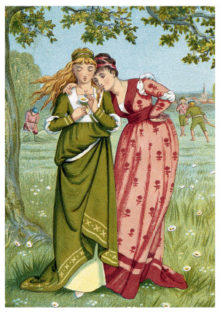 Daisy flowers are perhaps the best known of all plant divinations for love. One of the most touching literary allusions to the daisy divination is found in the garden scene in the first part of Goethe’s famous drama, Faust. In Germany, the daisy was known as:
Daisy flowers are perhaps the best known of all plant divinations for love. One of the most touching literary allusions to the daisy divination is found in the garden scene in the first part of Goethe’s famous drama, Faust. In Germany, the daisy was known as:
- Orakelblume – Oracle Flower
- Liebesblume – Love Flower
- Massliebchen – Little Measure of Love
Divination with daisies most commonly consists of removing each petal from the daisy while saying “she loves me, she loves me not.” (The masculine pronoun is used where appropriate.) The sentence stated as the last petal removed reveals the truth. Any daisy-like flower can be used.
This technique can be further improved upon by placing daisy roots under your beneath your pillow to dream of your true love.
A second form of daisy divination isn’t limited to matters of love. Ask a binary question. As you pluck each petal, say yes or no. As the last petal falls, the answer has been given.
A very short poem from the 1800’s gives us this variation:
- He loves me
- He don’t
- He’ll have me
- He won’t
- He would if he could
- But he can’t
- So he won’t
Another form of daisy divination is as follows:
Get a bunch of daisies and put them on a table. With eyes closed, take a handful while asking how many days you will wait to be asked for a date. If you prefer, you may ask in weeks or months. Open your eyes and count the picked daisies. The number of flowers represents the number of days you will wait. This can also be used to count the time till you will marry.
This can also be done while sitting on a daisy-laden lawn, closing your eyes and grabbing a handful of grass. The number of daisies you end up with in your hand will determine the number of months until you marry. If you do not have access to a daisy filled yard, dandelions make for an acceptable substitute.
Collected from various sources
- Ruler: Hermes, Aemgus, Artemis, Diana
- Type: Tree
- Magickal form: Branch, Nut, Catkins
The Hazel is a holy tree, associated with poetry and knowledge, fire and fertility. Hazel is one of the nine sacred woods used to kindle Need-fire at Beltane and other great festivals. It’s nuts are associated with love and child-birth, and are used in divination.
Hazel wood is excellent for making all purpose magickal wands, it is one of the most powerful wands for divination. Wands made of this wood symbolize white magick and healing. Dowsing sticks (forked sticks) are used to find water, buried treasure, and locate lost objects.
If you are outside and in need of magickal protection quickly draw a circle around yourself with a hazel branch. For protection while walking, wrap hazel twigs or branches around your walking stick or cane.
Eat the nuts to draw love and wisdom into your life. Eat together with a lover to increase the length of the relationship. To clear a stubborn cough, finely powder the nuts and mix with water and honey.
To enlist the aid of plant fairies, string hazelnuts on a cord and hang up in your house or ritual room. Magically, hazel wood is used to gain knowledge, wisdom and poetic inspiration. Weave hazel twigs into a crown. Put this on your head and wish very hard. Your wish may come true!
Twigs of Hazel are placed in window frames to protect the house against lightning, and three pins of hazel wood driven into your house will protect it from fire.
In England, branches of Hazel leaves gathered on Palm Sunday and kept alive indoors in water were said to protect the house from thunder and lightning. In Wales, fresh hazel leaves worn as a chaplet for the head brought general good luck and ensured the granting of wishes, as well as protection for those at sea from shipwreck.
At lambing time, if the catkins are brought indoors and set about the rooms, it is helpful to the sheep.
Scottish children born in autumn were sometimes given the ‘milk’ of the hazelnut as their first food, for that brought good luck and health. If, later on, they did not thrive as they should, they were strengthened with doses of the ‘milk’ mixed with honey.
The air surrounding hazel trees is said to be magically charged with the quicksilver energy of exhilaration and inspiration. In 19th century Germany, it was thought that there were witches beneath the bark of hazel trees – hence only peeled branches were allowed in churches.
The Hazelnut is a magical tree for relaying messages, which is why a Y-shaped Hazel branch is used for divination. To dream of, or to have a hazelnut tree show up in an unusual way may mean the answer to a dilemma is imminent. To dream of a Hazelnut tree also predicts wealth as well as unexpected good fortune.
Because the Hazelnut tree bestows powers of wisdom, symbolized by the cracking of the nutshell to get to the nourishment inside, a hazelnut or hazelnut tree may also mean that you will crack a situation.
The nut and shell also represent the heart within the body and female fertility, because the nut is like a baby inside a mother’s womb. With such life-giving qualities, this tree is an auspicious sign that love and new projects have the magical ingredients for success.
Male and female flowers, being borne on separate trees, forecast a lover’s meeting.
Collected from various sources
- Magickal Purpose: Justice, royalty, the psychic, meditation, idealism, mysticism, guidance, divination.
- Magickal Uses: Protection, justice power, spirit contact, breaking of bad luck, drive away evil, divination, spiritual and psychic powers, Astral Projection. This color is good to use when you don`t have a white candle.
Purple is the color of power, influence, success, idealism, psychic manifestations, prophecy, and wisdom. Burn purple candles to increase business. It is ideal for rituals to secure ambitions, independence, financial rewards, or to make contact with the spiritual other world.
Purple is also a great color for those pursuing higher education. Use purple candles in love spells to make a partner stay at home and remain faithful. Purple altar cloths are the best choice for psychic work or to wrap up tarot cards. This color increases Neptune energy.
Here are the magickal correspondences for the color purple:
- Element: Air
- Direction: East
- Chakra: Brow Chakra
- Planet: Jupiter
- Day: Thursday
- Number: 7
- Magickal Tools: Wand, Cauldron
- Scent/Essential Oils: Cedar, Carnation, Nutmeg Lotus, Angelica, Bay, Cinnamon, Ginger, Sandalwood, Jasmine.
- Plant/Herb: Mimosa, Wisteria, Mugwort Hazel, Eyebright, Rowan, Elder, Rue, Shamrock, Clover, Oak, Dandelion, Betony, Meadowsweet, Begonia, Cactus, Dahlia, Iris, Violet.
- Tree/Wood: Willow, Lilac, and Mulberry.
- Animal: Elephant, Unicorn, Rabbit, Jaguar, Chickadee, Cuckoo, Eagle, Elk, Penguin, Vulture, Grasshopper, Chameleon, Lizard.
- Feather: Spirituality, religion
- Minerals/Stones: Amethyst, Sapphire, Lapis Lazuli and Beryl, Clear Quartz, All Opals
- Tarot: Justice, Fours.
- God: Anase, Apollo, Forseti, Ida-ten, Mishara, Mithras, Musku, Tyr, Varuna
- Goddess: Aleitheia, Astraea, Athene, Hecate, Justita, Kali, Maiat, Mens, Morrigan, Syn, Oya
- Personality: Proud, independent, mystical arts, religious nature. This Person will not turn a blind eye, if they feel a cause of action is wrong, no matter the side they take.
Collected from various sources including The Encyclopedia of Magickal Ingredients and realmagick.com
- Scientific Name: Cucurbita
- Folk Name: Pumpkin, Winter Squash
- Type: Food
- Ruler: Oshun, Hekate
- Element: Water
- Parts Commonly Used: Seeds, Flesh, Whole Fruit
- Basic Powers – the fruit: Protection, Divination, Banishing, and Prosperity
- Basic Powers – the seeds: Fertility, Abundance, Wealth, Love, Prosperity, Good Luck
Basic Info:
Pumpkins can be used for protection, divination, banishing, and prosperity. Pumpkins and pumpkin seeds represent fertility, abundance, wealth, love, prosperity, good luck, and can attract money. They can also be used for healing, honoring the Moon, and Divination/Contacting the Spirit World.
Pumpkins have a long history of being the one vegetable that can ward off evil spirits on Halloween night. The tradition of carving pumpkins with faces, comes from Celtic traditions where turnips and other bulbous vegetables where cared to keep away evil or mischievous spirits during Samhain. To the Celts the head was the most sacred and important part of the body. So creating faces and turning them into lanterns made perfect sense.
Another legend tells us that we carve and light pumpkins so that our ancestors can find us and can communicate with us. At Samhain, the veils between the realm of the living and the dead are at their thinnest, and those who have passed on can cross over into our world, albeit for a short time.
Pumpkins are often symbols of the fruitfulness of the earth at this autumn time of year since their round orange bodies also represent the abundance of the Mother Goddess or Mother Earth. Pumpkin seeds, when roasted, dried and eaten, are believed to keep extra pounds away while adding the fruit of the pumpkin itself to delicious delights such as pumpkin bread or pumpkin pie is said to bring money and luck your way as well.
This fruit is also sacred to the Yoruban goddess Oshun and is offered to her in exchange for wishes granted concerning love, money and fertility. Offer whole pumpkins smeared with honey to the river where you wish to conceive a child. Offer whole pumpkins with names carved into them for love spells. Throw a handful of pumpkin seeds into the river and ask for a financial boon. It is important to know that the pumpkin and its seeds are considered the children of Oshun. If you are working with her magick, you must abstain from eating any pumpkin.
Other magickal uses for pumpkins include:
- When doing tarot readings for others, place a small pumpkin near your cards so you can draw upon it’s energies to reveal the unknown.
- Place a pumpkin on your altar and/or light a pumpkin-scented candle when doing any magic that involves discovering and developing your magical skills.
- For protection, carving ghoulish faces into pumpkins and placing them at your doorstep is said to help protect your home from wandering, harmful spirits this time of year.
- Light pumpkin-scented candles near your divination or scrying tools to increase the potency of your readings. Alternatively, keeping a pumpkin in your divination space is said to provide extra insight in your reading.
- Place pumpkin scented sachets around your home to drive away harmful energy and make your home warm and inviting.
- Pumpkins as a symbol of prosperity and can be placed on the altar, hearth, and doorstep to bring prosperity into the home and to those who live in it.
- Some believe the energy from Pumpkin scented candles helps to increase the power of spells.
These are just a few ways to use pumpkins in your magical practice. Remember, pumpkins are linked to the mysterious, the unknown, the dark, and all kinds of magic, so use them often!
A note of warning:
Some say that early American legend maintained that leaving a half of a pumpkin open or exposed in any room, but especially the kitchen, would attract negative energies into your living space. Pumpkins that have begun to spoil were believed by the Romany to suck the life energy from the people around them, and create illness and bad luck.
Related Content:
- Blends and Recipes – Magickal Apothecary/Pumpkin
- Spells and Magick – Book of Shadows/Pumpkin
- Folklore – Gypsy Magick/Pumpkin
Information in this post was collected from a variety of sources.
